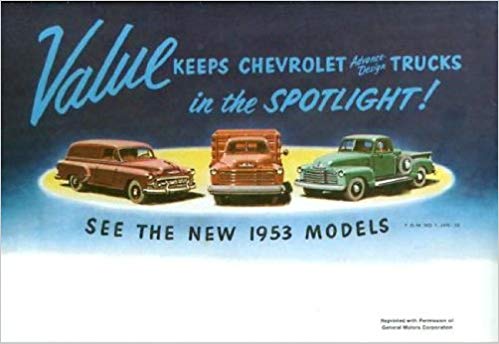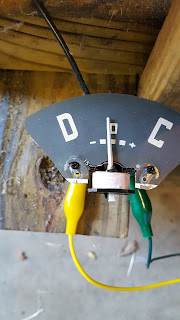So, another small project to keep me in the game. This project, however, is needed for the restoration, not just because I thought it would be cool. This project started the restoration of the gauge cluster. Some time ago, I found a write up on changing the truck's ammeter to a voltmeter on the Stovebolt.com forum. I thought that the rationale for doing the swap that was included in the write up made good sense, so I decided that I would do it. I read that write up many times over the months, thinking through the process before actually getting the parts ready and starting.
The project itself was actually pretty easy to do. Some of the steps were kind of tedious, but all in all it went pretty quickly. Here's a shot of the gauge cluster and the ammeter before the conversion:
Given the corrosion on the exterior trim ring of the gauge cluster, I was pleasantly surprised to find the inside of the cluster free from corrosion or crud. Now, on to the conversion....
I started with a Bosch voltmeter that I got from my local FLAPS (friendly local auto parts store). It was very inexpensive, costing less than $20. It looked like this out of the box:
The first step in the conversion process is to disassemble the new voltmeter. This involves grinding the edge off the black trim ring. Once that edge is gone, you can remove the front of the trim ring. Then you have to remove the the retaining nuts on the rear of the gauge. Once the nuts are removed, the insides of the gauge can be separated from the case. The disassembled contents look like this:
In this picture, you can see the case, front trim piece, white vibration insulator, actual gauge, electrical insulator from rear of case, lock washers and retaining nuts.
The next step in the conversion is to remove the tiny screws that hold the dial face to the gauge. Jewelers screwdrivers made quick work of removing the screws. A note of caution was provided in the Stovebolt.com write up and is worth repeating here. Those tiny screws go into tiny plastic screw bosses. Over tightening them will break those bosses. Here's a pic of the dial face and screws once they were removed:
I included the jeweler's screwdriver for size reference. Here's a shot of the gauge after dial face removal:
Another note of caution: Notice the thin wire wrapped around the dial face screw bosses? It is a very thin wire and appears that it would be easily damaged. In this pic, I'm test fitting the gauge in the gauge cluster. The gauge would need trimming before it would fit properly. This was expected, based on the Stovebolt.com article. Here are some shots showing why it needed the trim.
Notice the gap between the case and the cluster trim ring?
And on the rear, the gauge's insulators protrude just a little too far and need to be trimmed down a bit. The trimming is a 2 step process where you have to trim both the edge that is visible and the little ledge that keeps the gauge from contacting the cluster mount. That is an awkward description, hopefully this pic, together with the one above will help explain better than I can.
In this shot, you can see the parts of the gauge that keep the actual gauge from contacting the metal of the cluster mount. The other reason that you need to trim these plastic pieces is shown in the next pic. It shows that the needle contacts the cluster trim ring without doing the trimming.
After the trimming, everything fit just fine. It looked like this:
And this:
While it looks like there is still a gap between the case and the trim ring, it isn't because of interference between the gauge and/or needle and the trim.
The next bit of adjustment is to the original gauge face. The original face had 2 dimples punched into it where it was riveted to the original gauge. The gauge face, once removed, looked like this:
and this:
The problem with the dimples was that it interfered with the needle. This is evident from this pic:
Also, the rivet holes were not in the right location for the screws to fit into the new gauge frame. So, I had to flatten the dimples and measure and drill new holes. Once flattened, the gauge face looked like this:
It's a little hard to see, but if you look hard, you can see the black dots where the new holes need to go. I used the new gauge face as a template for locating the holes on the old face plate. One other adjustment to the gauge face that you can kind of see is that the opening that surrounds the needle had to be enlarged. That was done with the Dremel and cut-off wheel. In actuality, the trimming was done before the dimples were flattened. You can see that in this pic, the trimming has been done, but the dimples remain:
Anyway, once all of that was done, I assembled the old gauge face to the new gauge and it looked like this:
The guts from the original gauge are next to the new one. I included the guts from the old gauge to highlight the one real telltale sign of the change. The old gauge reads zero when it's not energized, which is in the middle of the gauge. The new one goes to zero, which is all the way to the left. A subtle difference, but different for sure. We'll see who notes it if I ever get the truck back on the road. Another slight adjustment was painting the needle from the original red, to a more correct white. For this, I just used what I already had on hand, which was Rustoleum flat white.
So, at this point, it looks pretty good...but does it work? Only one way to find out. So, I used some test leads and hooked it up to the engine test stand car battery. It's a normal car battery, connected to a trickle charger. The gauge performed like this:
If you remember from the pic of the original Bosch gauge face, 13 volts is the midway point of that gauge and the zero is the midway point of the original gauge. So, this gauge is reading about 12 volts on my battery connected to the trickle charger. With the engine running, I would expect it to read just above the zero, indicating about 14 volts. Pretty straightforward. Here it is in the original gauge cluster frame:
Here it is connected to the battery, still showing about 12 volts, which shows that the electrical connections are good and separated. Here's a shot of the back, with the insulator in place:
If you enlarge the pic, you can see that Bosch was nice enough to emboss the (+) and (-) on the insulator. Thanks, Bosch! Of course, you do have to orient them in the correct position or the gauge will read backwards!
So that's it! The ammeter is gone, replaced with a voltmeter. The risk of burning my truck to the ground is greatly reduced. Now, I have to address each of the other gauges. I think that I'm going to use a voltage reducer for the gas gauge and retain the original oil pressure gauge. The only wildcard right now is the water temp gauge. I kind of bollixed up that one when I was taking the gauge cluster out of the dash. So I either have to buy an original one and hope that it works or buy a new one. Maybe I'll look into moving the original gauge face onto a newly manufactured gauge. We'll see....




















